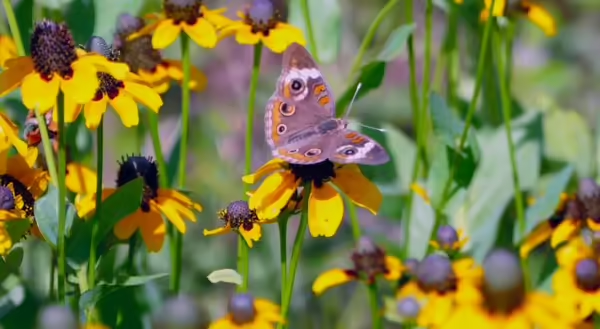
Each year in the United States, over one million acres of native habitat are transformed into urban and suburban lawns. The loss of these native plant resources is directly related to the decline of the native bird population by 3 billion birds. As news of species decline becomes more common, University of Illinois Extension has significantly increased the native plant educational programs to address this concern.
In February of 2020, Nicole Flowers-Kimmerle, Extension horticulture educator serving Fulton, Mason, Peoria, and Tazewell counties, delivered a native plants program to the Alliance of Illinois Cemeterians.
“The program was well-received,” Nicole commented, “The 85 participants seemed eager to add native plants to their properties.”
“Our Master Gardeners and Master Naturalists are big supporters of using native plants and educating others about it,” Nicole stated. “In April 2021, I shared the native plants program with a group of 50 master volunteers during an online program. We also sent the recording to the whole group of nearly 150 to watch on their schedule. Additional print resources have been added to the program to share the information with others.
Master volunteers have created many projects to share their knowledge of the importance of native plants and the creatures they support. Projects such as the native flower beds at Wildlife Prairie Park, the Kim St John Butterfly Habitat, Jubilee College Historic Site, a new pollinator garden at the Peoria Zoo, a native plant garden in Pekin, and the new native prairie project at Peoria County Juvenile Detention Center provide concrete examples of the beauty and ecological benefits native plants provide.
In addition to these sites, Master Naturalists Jeff and Nancy Staecker have launched a program called Lawns to Blooms to Birds. This program encourages landowners to add native plants to their lawns by starting small and adding on as they can. They have created a brochure with good, better, best practices listed to create spaces with more significant ecological benefits.
A native plant sale, run by Extension Master Gardeners, takes place in early May. These Extension Master Gardeners are committed to ensuring that native plants are available to those who would like to add them to their property. They also help to educate the buyers on the critical impact of native plants and good growing practices.
Education about native plants and their impact on food webs is becoming increasingly necessary as habitat is lost due to climate change and urban expansion. Even small greenspaces make an impact to reduce habitat loss and support life.
MEET THE AUTHOR
Nicole Flowers-Kimmerle is a Agriculture and Natural Resources (Horticulture) Educator for Fulton, Mason, Peoria and Tazewell counties. She completed a bachelors of science degree in crop science at the University of Illinois, and a master’s of science degree in agronomy with an emphasis in weed science at the University of Wisconsin-Madison. She has also worked at Montana State University as a research associate where she worked on weed control in sugar beets and barley. She taught high school chemistry and other science classes where she was able to teach students in both the school garden and greenhouse. She works with both the Extension Master Gardeners and Extension Master Naturalists.
ABOUT EXTENSION SNAPSHOTS
Extension Snapshots are monthly impact reports that share the stories of our programs in Fulton, Mason, Peoria, and Tazewell counties. To have them delivered to you directly sign up using our E-blast registration.